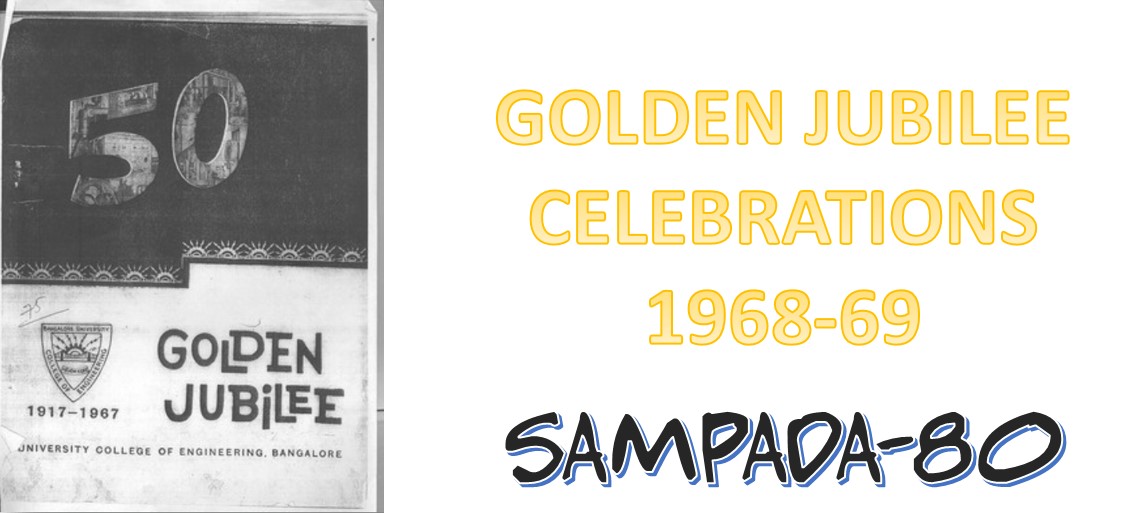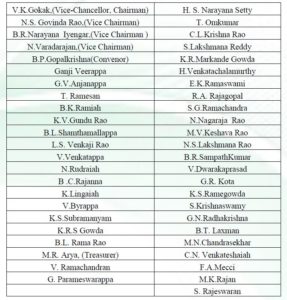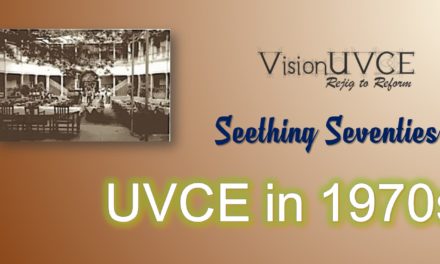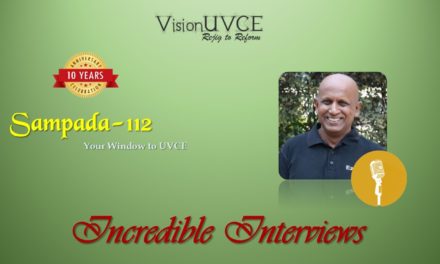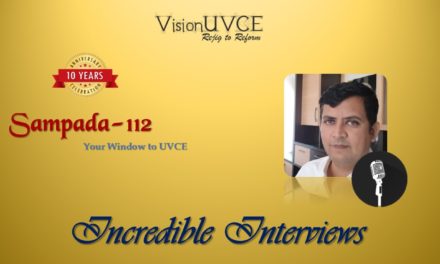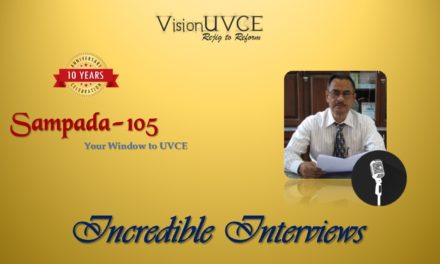Here is an excerpt from the Golden Jubilee Celebrations Souvenir. UVCE’s Golden Jubilee Celebrations that happened in the year 1967 which was a true spectacle to the eye and a memory to be never forgotten says the article!
STRIKING A CHORD OF CELEBRATIONS! It is a pleasure to contemplate that our College, the University College of Engineering, Bangalore, has completed its 50 years and that we will be presently celebrating its Golden Jubilee. This souvenir is intended to mark the happy occasion. We have endeavoured to present in these pages some idea of its history over the years.
As in the case of all good schemes that Mysore state had the privilege to possess or enjoy, the University and the associated Engineering College owe their origin to that farsighted statesman ruler, Sri Sri Krishnaraja Wadeyar, and his able Dewan, Sir M. Visvesvaraya, both of revered memory. At that time, it was the first Engineering College to be established in any native State and the first in the whole of India.
From small beginnings in 1917, it has grown steadily over the years into its present stature. There has been no looking back at any time and its has always held quite a respectable place among the technical colleges in the country. The College owes its progress to the bold and enlightened policy of the successive administrations; and to the ability and devoted efforts of its successive Principals. The Professors and other staff have also ungrudgingly given of their best to the College. To all of them our grateful thanks are due.
Since its inception the Engineers coming out of its portals have acquitted themselves creditably in the professions. Many have held senior responsible positions in several undertakings, projects, Government departments and educational institutions all over the country. They have brought name and fame not only to themselves but also to the College which ushered them into the profession. To all of them our best wishes. To get up the saga of an institution of this kind and to chronicle even the main events which have gone into the making of half a century of its history is a big task. Indeed, the present editors have at times felt whether it could not have been placed on worthier shoulders. However, we have attempted to present the same in as acceptable a form as possible. There are shortcomings, no doubt, but our kind readers will pardon us. Even the little we could do we owe largely to the encouragement, guidance and co-operation of many friends. It is a pleasant duty to record our grateful thanks to all of them. To those personages, who have been kind enough to honour us with their messages, we are deeply beholden.
We thank Principal B. P. Gopal Krishna and Heads of other Departments of the College for help received in various ways; the several authors and advertisers who have kindly responded to our request, the College Office staff; and the members of the Souvenir Committee for their suggestions. We express our gratitude to the Director of Printing and Stationery for executing the work so nicely and at short notice. Our special thanks are due to Sri B. N. Ramamurthy, the Senior Deputy Director of the Press, who being himself an alumnus of this College, has taken personal interest throughout in bringing out this journal.
BACKDROP
To give relief to the public affected by the great famine of 1882, rural irrigation and other projects including the laying of railway line between Bangalore and Mysore were undertaken. Mysore State was well known for irrigation works. In the early days the Public Works Department was manned by importing some engineers from outside the State. The posts of the Chief Engineer and the Deputy Chief Engineer were held by European Officers some of whom were from the Corps of Royal Engineers of the British Army and amongst these Col. Bewan distinguished himself with his organizing capacity.
A number of projects were taken up and to meet the increased demand for Engineers and to give an opportunity to the boys of Mysore, a College of science was started and engineering was taught there. It was wound up after training a batch or two. Later, to meet the needs of personnel for replacement due to retirement, etc., selected science graduates were sent to the Engineering Colleges at Madras and Poona. They were awarded stipends or scholarships.
When Sir K. Seshadri Iyer put up the Hydro-electric station at Sivasamudram against opposition to meet the needs of the mills at Bangalore and Gold Mining companies at Kolar Gold Fields for cheap power he established the Electrical Department. This was the first of its kind in the whole of India. To meet the requirements for higher posts, graduates were selected and sent out to USA and other countries on Damodaradas scholarships. Later when a committee to establish a research Institute with the munificence of the Tatas were on the look out for a suitable site, Sir Seshadri Iyer offered liberal grants of land and money as he also realized that for the development of Industries research was necessary. To this Indian Institute of Science graduates were sent for qualifying themselves in Electrical Engineering.
When Sir M. Visvesvaraya, who succeeded late Capt. Dawes-who met his end under tragic circumstances –as Chief Engineer, was appointed as Dewan, with his characteristic zeal he submitted proposals for the rapid development of irrigation and power resources of the State and for starting of Industries and enlarging of the communication systems. The single railway line between Mysore and Bangalore was earlier forced to be handed over to the Southern Mahratta Railway for purposes of running, by late Lord Curzon. Due to change of political climate however, the same was handed back to the Mysore Government about 50 years back. Several meter gauge and narrow gauge lines were constructed and a separate department was opened. In the field of irrigation, the Vanivilas Sagar Works which was the biggest one at the time was taken up as an irrigation and power project. This is the first multipurpose project in India and perhaps in the world. With the construction of KRS Works, the power generation at Sivasamudram was augmented as it was no longer a ‘run of the river’ system but one with a large storage to back it.
THE BEGINNINGS
The Mechanical Engineering School was started in 1913.The required buildings were put up between the Cenotaph Road and the Post office Road. This is the beginning of the present main building of the College facing the Sri Krishnarajendra Circle. Only the frontage and a short length of the wings on either side were constructed. The Central portion now housing the library was also put up at that time. Some structures and sheds were put up to house the shops, smithy, carpentary and so on.
When the College was started all these came in handy and served as a nucleus around which one could build to secure the necessary accommodation. It was also convenient in a way, since at that time the Engineering school and the College had to work in co-operation the shops and equipment of one being used by the other.
On the western side of the Post Office Road, at its junction with Seshadri Road in the same K. R. Circle, the then Electrical Department had put up some buildings, car barn as in those days the Department had planned to run a tram way service in the City. It is of historic interest to note that the necessary equipment had actually been ordered and even shipped from the U. S. A. The famous German raider Emden torpedoed the ship, It was the period of the first World War. The equipment and the ship and along with them the plan to have tramway in Bangalore all went to the bottom of the sea forever. Anyway these buildings were acquired for the use of college. From these small beginnings the present complex of buildings on either side of the Post Office Road has grown up.
There is now a proposal to have a separate University campus. A description of the new campus site is also included herein. In due course the College will find its new habitation amidst sylvan, verdant surroundings far removed from the hustle and bustle of the City.
MAIN COMMITTEE OF GOLDEN JUBILEE CELEBRATIONS
There were sub-committees for Finance, Reception and Assembly, Seminar, Souvenir, Sports, Exhibition, Refreshment, Co-ordination – the details of each Committee members listed in detail in the Souvenir.

